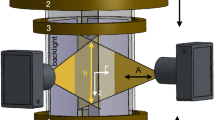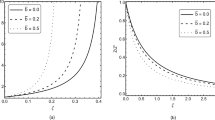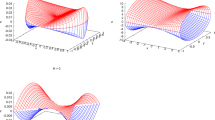Abstract
The stability of a spherically symmetric aggregate of point gravitating particles relative to arbitrary small perturbations is studied. It is assumed that in the absence of perturbations the particles move along circular trajectories chaotically oriented in space so that the total moment of the aggregate is zero. Dimensions of the aggregate are large in comparison to the gravitational radius, and particle velocities are nonrelativistic. It is shown that there exist initial mass-density distributions unstable relative to any perturbations with the exception of radial and dipole perturbations. A general stability criterion is formulated, with the form dΩ2/dr > 0, where\(\Omega ^2 = (4\pi G / r^3 )\int\limits_0^r {p_0 r^2 dr, \rho _0 (r)} \) is the aggregate mass density, and G is the gravitational constant. The dependence of the increment onl, the perturbation harmonic number, is studied. In the case of weak inhomogeneity r(dΩ2/dr)/Ω2 ≪ 1 the increment is maximum for quadrupole perturbations (l = 2) and decreases monotonically with increase inl. In the opposite case of high inhomogeneity r(dΩ2/dr)/Ω2 ≫l the increment increases with increase inl. In the case of weak inhomogeneity the increment may be as small as desired. For high inhomogeneity, instability develops over a time period smaller than the period of revolution of an individual particle. For dΩ2/dr < 0 the system is stable. Consideration of system microstructure in this case leads to damping of macrooscillations (system “heating”).
Similar content being viewed by others
Literature cited
M. Ya. Pal'chik, A. Z. Patashinskii, V. K. Pinus, and Ya. G. Epel'baum, “Oscillations of an Einsteinian model of a spherical star aggregate,” Preprint In-ta Yadern. Fiz., Sibirsk. Otd. Akad. Nauk SSSR, No. 99–70 (1970).
I. M. Gel'fand, R. A. Minlos, and Z. Ya. Shapiro, Concepts of Rotational and Laurent Groups and Their Applications [in Russian], Fizmatgiz (1958).
E. Kamke, Handbook of Ordinary Differential Equations [Russian translation], Fizmatgiz, Moscow (1961).
A. B. Mikhailovskii, A. M. Fridman, and Ya. G. Epel'baum, “Plasma theory methods in the problem of gravitational stability,” Zh. Eksp. i Teor. Fiz.,59, No. 5 (1970).
A. B. Mikhailovskii, A. Z. Patashinskii, A. M. Fridman, and Ya. G. Epel'baum, “Stability of a spherical star aggregate with high gravitational red shift,” Preprint In-ta Yadern. Fiz., Sibirsk. Otd. Akad. Nauk SSSR, No. 341 (1969).
M. Ya. Pal'chik, A. Z. Patashinskii, and V. K. Pinus, “Unstable spherical galaxies. Stable spherical galaxies,” Preprint In-ta Yadern. Fiz., Sibirsk. Otd. Akad. Nauk SSSR, No. 100-70 (1970).
Additional information
Translated from Zhurnal Prikladnoi Mekhaniki i Tekhnicheskoi Fiziki, pp. 63–73, November–December, 1974.
The authors thank Ya. B. Zel'dovich for his stimulating discussions of the study.
Rights and permissions
About this article
Cite this article
Pal'chik, M.Y., Patashinskii, A.Z. & Pinus, V.K. Stability of a spherical star system. J Appl Mech Tech Phys 15, 782–790 (1974). https://doi.org/10.1007/BF00864597
Received:
Issue Date:
DOI: https://doi.org/10.1007/BF00864597




